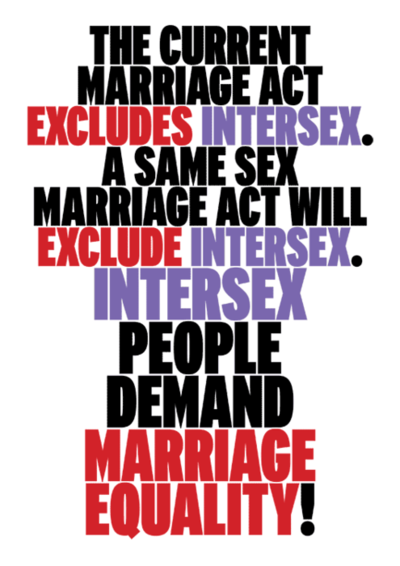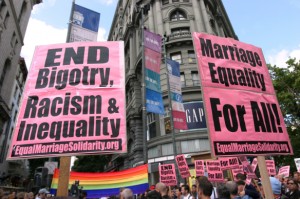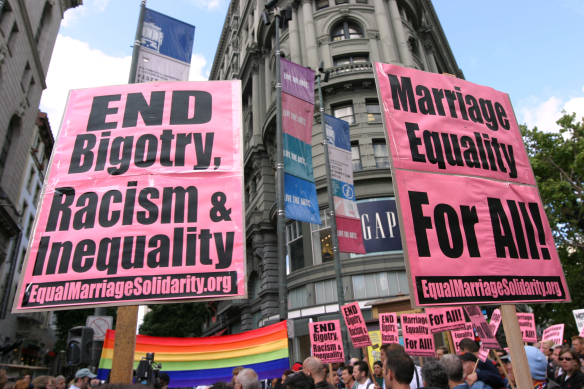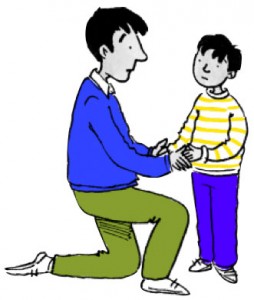In current debates on marriage equality, it’s usually assumed intersex people (read Part One on biology and medicine here) will gain equal rights when gay marriage has been legalized or that they already have equal rights. Unfortunately though, neither is the case.
 Terminology is of much importance here. The short version of this long story is that intersex people won’t have the undisputable right to marry as long as definitions of marriage rely on descriptions such as „same-sex“ or „opposite-sex“, or even “male” and “female”. This isn’t about “gay marriage” – bisexuals wish to marry as well – and it’s not a matter of “same-sex marriage” either, because this one still leaves intersex people in uncertainty.
Terminology is of much importance here. The short version of this long story is that intersex people won’t have the undisputable right to marry as long as definitions of marriage rely on descriptions such as „same-sex“ or „opposite-sex“, or even “male” and “female”. This isn’t about “gay marriage” – bisexuals wish to marry as well – and it’s not a matter of “same-sex marriage” either, because this one still leaves intersex people in uncertainty.
There is some overlap in the issue of marriage equality for intersex and transgender people. In the UK the case Corbett v. Corbett determined in 1970 that a marriage must be between one male and one female. This view of marriage has been codified in Section 11(c) of the Matrimonial Causes Act of 1973. In Corbett v. Corbett the marriage of a man to his transsexual wife was nullified when he sought an easy divorce and used her transsexuality against her, because the judge found she was still “really male”, as specified on her original birth certificate. This case led to birth certificates of transsexual and intersex people no longer being corrected until the introduction of the Gender Recognition Act 2004. This also means, however, that for those who do not possess a Gender Recognition Certificate, nothing has changed since the Corbett v. Corbett ruling.
In the Family Court of Australia case of C and D (falsely known as C) (1979) a wife sought an application for a declaration as to the validity of her marriage to an intersex man. A judge then nullified the marriage as “[…] the definition of ‘marriage’ as understood in Christendom is the voluntary union of one man and one woman to the exclusion of all others for life and a marriage in the true sense of the word within that definition could not have taken place and did not exist.” Clearly, what that judge meant weren’t “man” and “woman” but “male” and “female”, but that’s just another example of our society’s – persisting – routine conflation of gender and physical sex.
Furthermore, the court found that “intersex [people] are not wholly male or female and in the matter of C and [D] his honour found that being of indeterminate sex [, intersex persons] were barred from marriage. The intersex individual in that matter had undergone significant surgery to confirm a male sex assignment and had cardinal documents revised to reflect that surgery […].”
In 2001 Re Kevin: Validity of Marriage of Transsexual, a court ruled that a transman’s proper sex was indeed the one specified on his most recently issued birth certificate and thus seems to have disapproved C and D. ‘Seems’ because it really isn’t entirely clear. Some contend it has, others, such as the Organisation Intersex International Australia, say that it hasn’t and that “irrespective of surgery or other medical interventions if [a person] is born Intersex [that person] remains intersex”. Which is technically correct of course. Biologically speaking, a transsexual person can never transition to the “opposite” sex either, but instead enters a state that’s biologically arguably intersex. Therefore, any trans* person who wishes to obtain a sex marker other than the one specified on their original birth certificate ultimately depends on the good will of whatever judicial system they find themselves in, instead of, or maybe in light of, biological facts that are difficult to interpret.
 In the most recent case known to me, the family of Nikki Araguz’s deceased firefighter husband Thomas Araguz filed two lawsuits in an attempt to take away the benefits she would receive. Thomas named Nikki as beneficiary and knew about her having been born intersex. She was diagnosed with Androgen Insensitivity Syndrome (AIS) and thus developed in a mostly female sex-typical fashion, despite having XY chromosomes and having been wrongly assigned male at birth. In May 2011 a Texas State District Judge nevertheless nullified the marriage. To him and Texas law, she simply isn’t female enough. This legal battle is ongoing and Nikki is scheduled to have another hearing in the spring of 2013.
In the most recent case known to me, the family of Nikki Araguz’s deceased firefighter husband Thomas Araguz filed two lawsuits in an attempt to take away the benefits she would receive. Thomas named Nikki as beneficiary and knew about her having been born intersex. She was diagnosed with Androgen Insensitivity Syndrome (AIS) and thus developed in a mostly female sex-typical fashion, despite having XY chromosomes and having been wrongly assigned male at birth. In May 2011 a Texas State District Judge nevertheless nullified the marriage. To him and Texas law, she simply isn’t female enough. This legal battle is ongoing and Nikki is scheduled to have another hearing in the spring of 2013.
As we’ve seen, their biological status can easily be used against intersex people in some jurisdictions. It can even be used against them by their own spouses, if they find out about the intersex person’s biological status and want the marriage nullified because of homophobia or want to use this fact against their former partner in legal battles after a faillure of their marriage. Let’s not even speak of other areas of the law, like protection against discrimination, where the status of intersex people is usually uncertain at best as well. Laws designed to protect transsexuals most often do not cover intersex people (just like they fail to cover transgender people who identify as neither man nor woman), one of the problems being that they rely on a binary language.
Considering the differences between one sex and its “opposite” are on average about 0.8 percent (that’s about four times their difference from their nonsex chromosomes, which is about 0.2 percent; overall humans differ from each other by about 0.3 percent), and how relatively arbitrarily people are assigned one sex or another, marriage equality still needing debate is rather ridiculous. Biological sex is such a blurry and poorly defined thing, and yet people insist on inventing mostly arbitrary categories that are then used to deny groups of people the equal rights they deserve as fellow human beings, determine who can wear skirts and play with dolls, become a priest, and blow minor gender differences out of proportion.
The International Olympic Committee already had to concede that neatly dividing people into male and female simply isn’t possible and gave up routine gender verification in 1999, although it is still used in individual cases. It’s time society at large, and most importantly lawmakers, catched on to that too. There is only one way to define marriage that won’t leave entire groups of people standing in the rain: Marriage is a union between consenting adult humans.
Sources:
Relatedness – Stanford at The Tech, Understanding Genetics
“Same Sex” Marriage? What Intersex Does to the Gay Marriage Debate
How Will Anti-Gay Marriage Laws Affect Intersexed People?
A question of sex – Sex is a complicated thing to define
Intersex and Marriage: The Fourteen Days of Intersex
Why intersex is not a gender identity, and the implications for legislation
What is the legal standing of intersexuality?
Gender verification in sports – Wikipedia
Making the Invisible Visible: Intersex Rights are human rights which should be protected under new equality laws
“Not Quite One Gender or the Other”: Marriage Law and the Containment of Gender Trouble in the United Kingdom by Dr. Lisa Fishbayn (PDF)
An annulment of marriage due to being intersex – In the marriage of C and D (falsely called C)
Nikki Araguz – PBS Video Interview
Senate inquiry supports marriage equality, talks about intersex
Senate enquiry into marriage equality: Gina Wilson (OII Aus) and Chris Meney (Catholic ‘Life, Marriage & Family Centre’) testify
Interview: The fight for intersex rights
Nikki Araguz – Wikipedia
Definition of Marriage: “Sex” Determined by Genes?
Anatomy and Same-Sex Marriage
____________________________________________________________________________________________________
Follow and ‘like’ the author’s Facebook page here —-> Faith McLay Official, to stay updated.
Intersex, Part Two: Marriage Equality,





Pingback: Sara Lin Starred It: 2013-04-02 (Beautiful Belly Edition) | saralinwilde